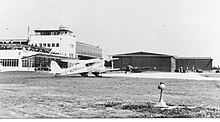| George Noel HillFRIBA | |
|---|---|
| Born | 1893 Liverpool, England |
| Died | 1985 Bournemouth, England |
| Citizenship | British |
| Education | King William's College, Isle of Man |
| Alma mater | University of Liverpool School of Architecture |
| Occupation | Architect |
| Years active | 1912–1958 |
| Known for | Manchester City Architect |
| Practice | Leicester Corporation Manchester Corporation Lancashire County |
| Buildings | Manchester City Police Headquarters; Wythenshawe Bus Garage |
| Projects | Ringway Airport |
George Noel Hill FRIBA (1893–1985) was a British architect. He was the City Architect of Manchester and the Lancashire County Architect.
G. Noel Hill was born in Liverpool, northern England, and educated at the King William's College, Isle of Man. He then proceeded to the School of Architecture at the University of Liverpool.
During 1912–1926, Hill worked with three private architectural firms in Liverpool. He also served in World War One during 1914–1919. In 1926, he was appointed senior assistant in the Liverpool City Architect's department. From 1928 to 1932, he worked as the chief architectural assistant in the Leicester Corporation Surveyor's department. While working in Leicester, he designed the Leicester City Police Headquarters and additions to Leicester Town Hall, including a Council Chamber and suite for the Lord Mayor of the city.



Hill then became the second City Architect at Manchester, succeeding Henry Price (1867–1944) when he retired in August 1932. In this role, he designed a new Central Police Headquarters in Bootle Street (1933–37) with a Portland stone facade, and was involved with the development of Wythenshawe including the Wythenshawe Bus Garage (1939–42) with a concrete shell, as well as a new Central Reference Library and Town Hall extension with the architect Vincent Harris. He also worked on Ringway Airport hanger (1937) and other buildings (1939), now Manchester Airport.
In June 1945, Hill was appointed to be the Lancashire County Architect, from which he retired in 1958. In Manchester, Hill was succeeded as City Architect by Leonard Cecil Howitt.
Hill was elected a Fellow of the Royal Institute of British Architects (RIBA).
References
- ^ Darlington, Neil (2024). "George Noel Hill". A Biographical Dictionary of the Architects of Greater Manchester, 1800–1940. The Victorian Society. Retrieved 30 December 2024.
- ^ "Obituary: George Noel Hill". RIBA Journal. 93 (2): 89. February 1986.
- ^ "Manchester City Police Headquarters – City Architect: G. Noel Hill [F.]" (PDF). RIBA Journal. 45 (7): 342–346. 7 February 1938. Retrieved 30 December 2024.
- ^ Darlington, Neil (2024). "Ringway Airport". A Biographical Dictionary of the Architects of Greater Manchester, 1800–1940. The Victorian Society. Retrieved 30 December 2024.
- ^ "Wythenshawe Bus Depot". mainstreammodern.co.uk. UK: Mainstream Modern. 2024. Retrieved 30 December 2024.
- "George Noel Hill appointment as City Architect". Manchester City News. 19 March 1932. p. 6.
- Glancey, Jonathan (26 May 2003). "The untouchables". The Guardian.
- "George Noel Hill appointed Lancashire County Architect". Manchester Guardian. 9 June 1945. p. 6.
- "George Noel Hill retirement". Manchester Guardian. 7 November 1958. p. 18.
This article about a United Kingdom architect or firm of architects is a stub. You can help Misplaced Pages by expanding it. |
- 1893 births
- 1985 deaths
- Architects from Liverpool
- People educated at King William's College
- Alumni of the University of Liverpool
- British military personnel of World War I
- 20th-century English architects
- Architects from Leicester
- Architects from Manchester
- Fellows of the Royal Institute of British Architects
- British architect stubs